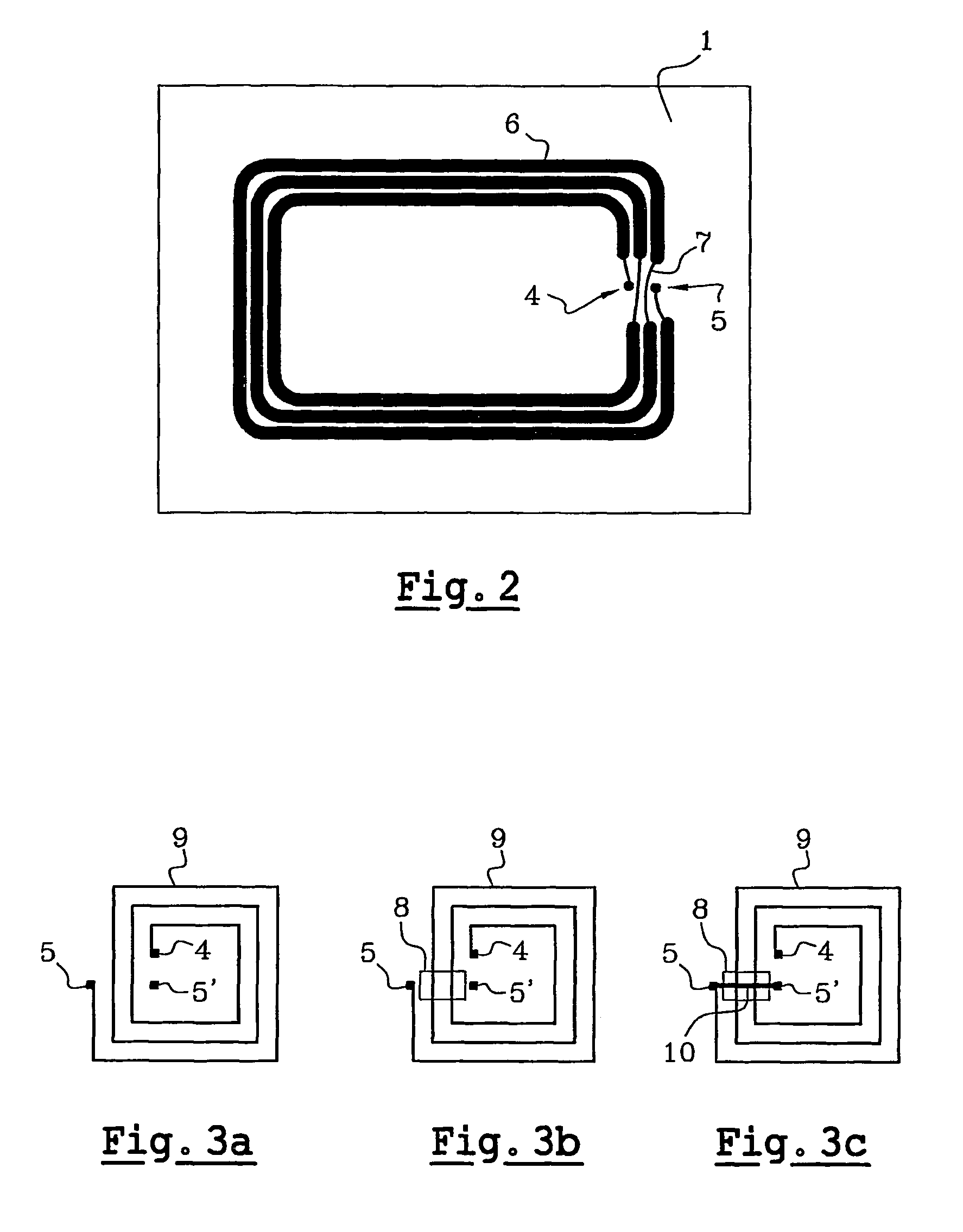Method for the manufacture of a printed circuit and planar antenna manufactured with this printed circuit
- Summary
- Abstract
- Description
- Claims
- Application Information
AI Technical Summary
Benefits of technology
Problems solved by technology
Method used
Image
Examples
first embodiment
[0032] shown in FIG. 2, it is planned to narrow the width of the tracks at each of the coils, at least locally, and bring them closer to each other at this level. Thus, each coil has a first portion 6 with a track width greater than that of a second coil portion 7. The second portions 7 are also brought closer to each other. With a gravure printing method, these portions can be brought closer together in this way because it is possible to obtain a track width of about 100 μm, and also an inter-track width of about 100 μm. The ends are thus sufficiently close to each other and the pads of the chip may be superimposed in order to be put into contact. This contact may be made, for example, by means of polymer or metal bumps deposited on the pads of the chip in order to connect the ends. In this case, the chip-antenna unit is then surrounded by a resin to protect the connection. In one variant, an anisotropic conductive film (ACF) or an anisotropic conductive paste (ACP), whose electric...
second embodiment
[0033] shown in FIGS. 3a, 3b and 3c, it may be planned to bring these two ends together by making a “bridge” to bring the second end close to the vicinity of the first one. In this case, to enable the second end to go above the coils, an insulating layer 8 is placed between these tracks and the second end. In this case, during a first run, the first end 4, first end 4 forming an internal pad, and an unconnected pad 5′ juxtaposed with the internal pad 4 are formed. The second end 5 forms an external pad and is not connected to the unconnected pad 5′. The antenna 9 planned in this embodiment is not yet obtained. Then, the insulating layer 8 is deposited and, finally, during a second run, the conductive bridge 10 connecting the external pad 5 of the antenna 9 with the unconnected pad 5′ is made. The bridge 10 goes above the insulating layer 8. Thus the second end 5 may be brought inside the smallest coil, in the vicinity of the first end 4. The two runs may be made serially by means of...
third embodiment
[0034] wherein the two faces of the carrier substrate may be used, it is planned to place a module containing the chip on that side of the substrate which does not have the tracks of the printed circuit. This module is then mechanically gripped on this face in such a way that it comes into contact with the ends of the antenna brought to the other face. However, this technique requires that the carrier substrate of the antenna should not be excessively thick, and that it should have a thickness at most equal to 50 μm.
PUM
| Property | Measurement | Unit |
|---|---|---|
| Thickness | aaaaa | aaaaa |
| Percent by mass | aaaaa | aaaaa |
| Weight | aaaaa | aaaaa |
Abstract
Description
Claims
Application Information
 Login to View More
Login to View More - R&D
- Intellectual Property
- Life Sciences
- Materials
- Tech Scout
- Unparalleled Data Quality
- Higher Quality Content
- 60% Fewer Hallucinations
Browse by: Latest US Patents, China's latest patents, Technical Efficacy Thesaurus, Application Domain, Technology Topic, Popular Technical Reports.
© 2025 PatSnap. All rights reserved.Legal|Privacy policy|Modern Slavery Act Transparency Statement|Sitemap|About US| Contact US: help@patsnap.com



